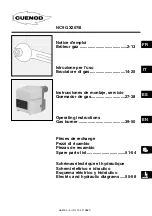
20160778
16
GB
Installation
4.4.2
Blast tube length
The length of the blast tube must be selected according to the indi-
cations provided by the manufacturer of the boiler, it must be great-
er than the thickness of the boiler door complete with its insulation.
The length available, L (inches), is as follows:
For boilers with front flue passes 15)(Fig. 8) or flame inversion
chambers, protective insulation material 13), must be inserted
between the boiler refractory 14) and the blast tube 12).
This protective insulation must not compromise the extraction
of the blast tube.
For boilers having a water-cooled front, the insulation 13)-14)
is not required unless it is required by the boiler manufacturer.
4.5
Combustion head calibration
At this point check, for model RS 130/M, whether the maximum de-
livery of the burner at high fire operation is contained in area A or
in area B of the firing rate. See Fig. 2, page 10.
If it is in area A then no operation is required.
If, on the other hand, it is in area B:
unscrew the screws 1)(Fig. 9) and disassemble the blast tube
2);
move the fixing of the rod 3) from position A to position B,
thereby causing the shutter 4) to retract;
now refit the blast tube 2) and the screws 1).
Once this operation has been carried out (if it was required), secure
the flange 11)(Fig. 8) to the boiler plate, inserting the gasket 9).
Use the 4 screws, after first protecting the thread with an anti-lock-
ing product.
The seal between burner and boiler must be airtight.
If you noticed any irregularities in the positions of the flame rod or
ignition electrode during the check mentioned above, remove
screw 1)(Fig. 10), extract the internal part 2) of the head and set up
the two components correctly.
Model
L
(short blast tube)
RS 70/M
10“
RS 100/M
10“
RS 130/M
11“
10
11
15
12
13
14
1
8
15
3
3
4
7
5
2
" L ' '
Fig. 8
20161071
Fig. 9
D738
Fig. 10
D2398
















































